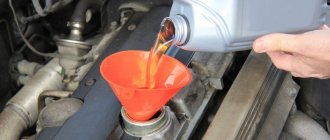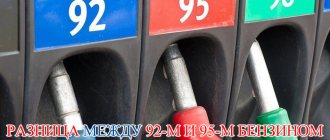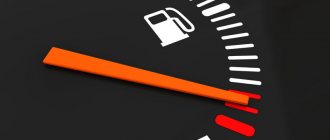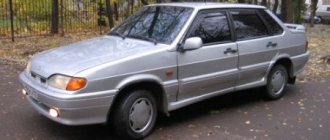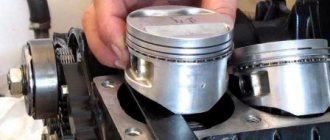As a rule, the Lada Granta is bought by those car enthusiasts who are interested in the opportunity to save money both on the purchase of the vehicle itself and on its operation. The mentioned model is precisely positioned by the manufacturer as a budget and compact model.
However, people are often interested in what the actual fuel consumption of the Lada Grant is per standard 100 km? This question often arises because many people record a significant excess of the indicator compared to the manufacturer’s promises.
In this article we will try to figure out how much fuel the Grant consumes for the mentioned 100 kilometers in reality.
Standard
The designers of the Volzhsky Automobile Plant confidently say that, according to the driving cycle, the Grant will burn approximately 7 liters of gasoline over a hundred kilometers. This volume is required, in particular:
- sedan;
- liftback.
At the same time, Granta Sport consumes only 6.8 liters according to the norm.
Not everyone understands what a drive cycle means. You should know that this is a kind of theoretical route in which everything without exception is precisely calculated:
- braking;
- acceleration;
- duration of the ride;
- its intensity;
- speed is both minimum and maximum possible.
If the car is equipped with a manual transmission rather than an automatic transmission, then the gear for each time segment of the driving cycle is also taken into account.
That is, in fact, such a route is nothing more than a theoretical construction that takes into account the manner of movement in populated areas, on rough terrain, and so on.
What factors influence a car’s fuel consumption and measures to overcome them?
In many ways, the amount of fuel consumption depends on the design features of the car and, in particular, on the power and engine size. But, as the example of foreign manufacturers shows, this is far from a decisive factor. Thus, when conducting a test drive of the Skoda Octavia 2013 with a gasoline engine of greater power and volume than that of the Lada Grant, the average fuel consumption was 10 - 15% lower. Therefore, let’s put the engine power aside and consider the reasons that may influence the change in this indicator for a given car. These reasons or factors can be both objective and subjective.
Objective reasons for excessive fuel consumption can be divided into those caused by malfunctions of individual vehicle subsystems and external factors.
Main malfunctions affecting fuel consumption:
- Incorrect operation of sensors responsible for optimizing the air-fuel mixture;
- Low or high pressure in the fuel system;
- Engine injector malfunction;
- Burnout or destruction of the catalyst;
- Malfunction of the engine cooling system;
- Air filter dirty;
- Wheel alignment violation.
If your Lada Granta's fuel consumption does not meet factory specifications, then it's time to go for diagnostics.
External factors:
- Ambient air temperature: the lower it is, the greater the consumption;
- Meteorological conditions: rain, snow, strong wind, ice increase this indicator;
- Location of the car: in the city or on the highway. Even a small traffic jam can increase gasoline consumption by 2 liters;
- Nature of the terrain: on a mountain road you will use more fuel than on a flat road;
- Quality of the road surface: fuel costs for driving on a dirt road are significantly different from driving on asphalt;
- Gasoline quality and brand: this car is designed to use AI-95.
You can’t really argue with external factors, so the following may be reasonable recommendations:
- If possible, refrain from traveling in adverse weather conditions;
- in prolonged traffic jams, turn off the engine;
- fill up with the recommended brand of gasoline at trusted gas stations.
Now the reasons are subjective. Their manifestation largely depends on the driver himself. These reasons include:
- Character and driving style: calm, measured movement, without frequent acceleration and braking will help save expensive fuel.
- Viscosity and quality of oil: the higher the class of lubricants and the viscosity compliance with the season, the lower the friction and, accordingly, the fuel consumption. And do not forget to promptly change both engine and transmission oil.
- Tire condition and pressure: Use the tire size recommended by the manufacturer. Different tire pressures can increase fuel consumption by 0.5 liters. Therefore, always check this indicator before your trip.
- The presence of additional cargo in the car: an additional 50 kg will increase consumption by 2%.
- The air conditioner is on, the windows are lowered when moving: two seemingly mutually exclusive concepts, but they both affect the increase in gas mileage, although the windows are lowered much less.
Now, dear reader, armed with the above knowledge, you can easily regulate the fuel consumption of your beloved Lada Grant.
How to find out the consumption yourself
The method described here allows you to determine as accurately as possible for your specific case the amount of fuel burned per 100 kilometers.
The procedure is as follows:
- Having used up the fuel as completely as possible, fill the tank to capacity, that is, until the dispenser pistol fires the first “shot”;
- the daily mileage scale is set to zero;
- after one day, compare the distance covered by the car with fuel consumption.
For example, if you drove a conventional 400 kilometers and consumed 31 liters of fuel, then dividing the amount of liters by the first number and multiplying the result by 100, we get 7.75, which is the real value for you.
By acting in this way, you will know exactly what the exploitation of Grants will cost you.
In principle, the Granta’s power plant belongs to the small-displacement category. Such vehicles in general are not capable of consuming a lot of fuel. However, there are many factors that directly influence this indicator. We will talk about them in more detail below.
Fuel consumption of 16-valve engines
Installing 4 valves per cylinder made it possible to reduce the load on the engine, which had a positive effect on reducing fuel consumption and at the same time increasing the power of the power unit. The cars were equipped with engines 21126 (98 hp) and 21127 (106 hp) with a volume of 1.6 liters. Frets with such engines had both a mechanical and a robotic gearbox. According to the passport data, fuel consumption standards per 100 km for cars with a 98 hp power unit. are:
- urban cycle - 9.9 l;
- highway - 6.1 l;
- mixed cycle - 7.6 l.
Despite the fact that the 21127 engine has more power, it consumes slightly less fuel:
- city roads - 8.6 l;
- highway - 5.6 l;
- mixed cycle - 6.7 l.
Actual costs differ from the passport costs and amount to 10-12 liters for the city and 7 -7.5 liters when driving on suburban highways.
Equipment
This is one of the most significant factors on which the overall fuel consumption of a car depends. In particular, we mean differences in:
- types of bodies;
- types of power units;
- electronic equipment;
- manual or automatic transmissions, etc.
For example, the sedan and liftback are each produced in three modifications. The difference lies in the power of the unit and, accordingly, their gluttony also varies. So:
- a 98-liter engine will burn 7.8 liters at normal rates;
- at 87 – 7.2;
- at 106 – 6.9.
It is worth knowing that the weakest of them has 8 valves, while the others have 16.
The designers made the only exception for Grants sport. This model is equipped with a 1.6-liter power unit (this parameter is the same for all cars), but its power is higher - 118 l/s. Moreover, the sports version is also equipped with a 5-position gearbox.
What is curious is that with all this, having a 16-valve engine, the above-mentioned model, according to the manufacturer’s standards, spends only 6.8 liters per hundred kilometers. This is a very modest figure in comparison with other relatives.
Fuel consumption of 8-valve engines
The first copies of the Lada Granta, which appeared in 2011, were equipped with gasoline injection engines models 11183 and 11186 with a volume of 1.6 liters and a power of 82 and 87 hp. respectively. The use of a power supply system with distributed injection and a lightweight connecting rod and piston group made it possible to achieve a reduction in consumption in all driving modes. With a combined cycle, the 82-horsepower Lada Granta has a gasoline consumption of 7.4 liters, and with the 11186 engine - 7.0 liters per 100 km. When driving in the city it will be 9.7 and 9.0 l/100 km, and on the highway - 6.1 and 5.8 l/100 km, respectively.
In fact, the fuel consumption of the sedan differs significantly from the official data: outside the city it is about 6.6 liters, and in the combined cycle - 8.5 l/100 km. Differences in fuel consumption largely depend on the operation of the vehicle under conditions that differ significantly from laboratory conditions (ground tests). The use of low quality fuel and lubricants makes a significant contribution.
Fuel quality
Reviews from owners of Grants indicate that the amount of consumption varies significantly depending on what kind of fuel is used to refuel it.
The manufacturer, for its part, recommends giving preference to a better brand, that is, AI-95. Moreover, practice confirms that the above-mentioned grade of gasoline is burned more economically than the cheap 92nd grade. At the same time, the difference is so significant that it is more profitable to use expensive fuel.
This circumstance should also be taken into account in order to optimize the operating costs of the vehicle in question.
Factors that affect fuel consumption of a car and how to overcome them
The amount of fuel consumption largely depends on the design features of the car and, in particular, on the power and engine size. But, as the example of foreign manufacturers shows, this is not a decisive factor. So, when conducting a drive test of the Skoda Octavia 2013 with a gasoline engine of greater power and volume than the average Lada, Grant's fuel consumption indicator was therefore 10 - 15%. Below, we will put the engine power aside and consider the reasons that may influence the change in this indicator for a given car. These reasons are factors or can be either objective, subjective, or so on.
Highway congestion
Driving around the city, as a rule, is seriously hampered by the abundance of cars on the streets. This constantly leads to traffic jams. As a result, engine operation requires more gasoline.
The situation is aggravated in winter and summer, when you also need to either heat the car interior or cool it.
In total, consumption can increase significantly under the influence of all the previously mentioned factors.
Principles of fuel economy
Reducing gasoline costs for the Lada Granta is not difficult at all. First of all, you need to understand that the deeper and more often you press the accelerator pedal, the higher your gas mileage. And the less often you use the gas pedal, the more fuel you will save. The main skill that is trained over time is the ability to brake with an engine. Any driver, if desired, can easily get used to rarely using the brake pedal.
When braking by the engine, the load on the braking system is noticeably reduced, Grant fuel is saved, thereby the brake pads and the entire braking system will last longer. When the engine decelerates, fuel consumption is zero. According to reviews from experienced drivers, the savings are at least 10 percent.
During colder months, the car takes longer to warm up. However, the modern Lada Granta has the ability to warm up while driving, and there is no need to warm it up for too long. On a cold engine, you should not just accelerate sharply. And if your goal is to save on gasoline, you should avoid slipping and accelerate smoothly and evenly.
Significantly more gasoline is consumed on rough or unpaved roads. Additional kilograms in the trunk of your car increase fuel consumption, so do not carry anything unnecessary with you. Low-quality automobile oils lead to various malfunctions of the Lada Granta engine and systems and increase the car’s fuel consumption. Carry out technical inspection of the car in a timely manner. By following these simple tips, you can reduce your gasoline costs.
Driving style
Fuel consumption also largely depends on it. Fans of speed and spectacular starts with sudden stops spend more fuel than calm car owners.
Moreover, when the driver constantly starts with a cold engine, the amount of gasoline burned usually increases by approximately 12 percent.
As previously noted, the operation of various electronic systems, including air conditioning, also requires fuel. The more gadgets and gadgets installed on a car, the more difficult it is to save gas.
Only one air conditioner can “eat” an additional 15 percent of the total volume.
Reducing fuel consumption on the Lada Granta
The modern world is characterized by constant, pleasant and not so pleasant, changes that affect the most diverse aspects of people's lives. Rising prices in general, and in particular rising fuel prices, cannot be considered a positive change.
Naturally, an upward change in gasoline prices forces the vast majority of car owners to seriously think about saving. Refusal to use a car is an extreme measure that very few motorists decide to take, but attempts to reduce fuel consumption are not only acceptable, but also completely feasible options. Below we will try to understand the issues affecting the topic of reducing fuel consumption on Grants.
Fuel consumption has increased sharply - we are looking for and eliminating the cause
In modern conditions, it is necessary for a car to work efficiently and not waste too much fuel. Otherwise, it turns out that the owner pays much more for operating the vehicle than he could pay. If your car has experienced an unpleasant and sharp increase in fuel consumption, you need to look for the cause, because this problem can arise due to very serious problems with the engine that need to be addressed urgently. Sharply increased fuel consumption often indicates the need for major repairs.
Consumption rarely increases without other obvious accompanying breakdowns. Often, along with an increase in gasoline consumption, other visual features of the problem appear. This may be a decrease in power, engine shaking during operation, as well as increased engine oil consumption. In any case, you need to contact a professional and diagnose the problem.
A sharp increase in fuel and engine oil consumption
One of the possible manifestations of engine problems is an increase in engine oil consumption. If at the same time the fuel begins to drain too quickly, there is reason to think about the need for a major overhaul of the power unit. This occurs due to increased wear of the pistons or metal in the cylinder block. This problem is corrected by boring the blocks and installing new pistons, which will also slightly increase the potential of the power unit. But problems can arise for other reasons:
- poor valve adjustment, low fuel combustion;
- poor quality oil and too high friction between engine parts;
- no oil changes for a long time, driving on old lubricant;
- low quality gasoline, a large number of additives harmful to the engine;
- poor performance of one of the cylinders, gasoline entering the crankcase and oil combustion.
These types of problems may occur with simultaneous increased consumption of gasoline and oil. You can find many reasons for this phenomenon, but the most common option is wear of the piston group, which can only be treated with a major overhaul. True, on many modern power units it is impossible to carry out overhauls because the walls of the piston group are too thin. The cylinder block cannot be bored, so the engine must only be replaced.
Increased fuel consumption due to poor settings
If your car has trouble starting, the engine runs rough, and your fuel consumption has increased significantly, do not rush to look for a contract engine and buy a used power unit to replace it. It’s better to take advantage of the opportunity for good diagnostics, because in most cases it turns out that the culprit for this engine behavior is poor settings. This can happen after visiting a low-quality service station. Often we are talking about the following possible problems:
- poorly set valve clearances, uneven opening and closing;
- failure in ignition timing settings, premature spark supply to the combustion chamber;
- broken on-board computer settings and problems with sending the correct signals;
- incorrect settings of the injector system that supplies fuel to the engine;
- Timing belt slipping and its position being knocked down.
Often such problems can happen completely by accident. After actively using the engine at high speeds, the valves sometimes need to be adjusted, and the ignition is often interrupted simply by sudden throttle changes. It is enough to appear at a service station once every 10-15 thousand kilometers to determine these problems. And if fuel consumption has increased spontaneously, then you should not wait for the end of the service interval - it is better to go right away and correct the situation.
A clogged fuel system is the cause of increased consumption.
A common cause of changes in engine operation is clogging of the injector or carburetor, as well as fuel filters, lines and other elements of the system for supplying gasoline or diesel fuel to the engine. Situations can be different, even the main cleaning filter in the tank is clogged. In this mode of operation, the car does not receive the required amount of fuel; the computer forces the gas pump to supply more gasoline to the chambers, which causes increased consumption. Possible solutions to the problem are as follows:
- diagnostics and cleaning of the injector, purge of injectors or carburetor maintenance;
- replacing fuel filters and cleaning lines;
- changing the usual gas station, experimental use of other fuel;
- complete inspection of the fuel supply system, cleaning of the gasoline tank;
- full check of the car at the service station on special stands and computers.
If you have a modern car, computer diagnostics will answer all the necessary questions. All that remains is to buy the necessary spare parts and entrust the repair work to specialists. Be sure to react to increased fuel consumption and other indicators of problems in your car, because only the correct reaction and quick actions will help eliminate the problem at the very beginning, without spending too much money and time on it.
Increased fuel consumption and poor engine performance
Often, increased gasoline consumption is associated with improper operation of one of the cylinders. This is a common problem that is not always immediately noticed by owners of expensive foreign cars. High comfort, isolation from noise and vibration, as well as the use of modern technologies make it possible not to feel in the cabin when the engine is shaking when one of the cylinders is not working. This forces the driver to overpay at gas stations, because when the cylinder is not working, the following things happen:
- the load on the engine as a whole and on each cylinder separately increases greatly;
- the computer commands to supply more fuel, including to the idle cylinder;
As a result, after a few weeks of driving with a bad cylinder, your car may require major powertrain repairs. In many cars, the only way to notice such a problem is to monitor fuel consumption. If previously your car consumed 10 liters per hundred, and today it suddenly begins to consume 18 liters, it makes sense to contact the service station today and stop actively using the car.
Perhaps you just forgot about preparing your car for winter, but everything is fine with the engine? Watch the following video for useful tips:
Let's sum it up
If you want your car's engine to always remain reliable and durable, always react to a sharp increase in fuel consumption. This factor shows us that the power unit has certain problems and will have to be repaired or even replaced. The faster you react to such engine indicators, the greater the chance of quickly fixing the breakdown and avoiding small financial losses.
To determine which unit is troubling your car, you need to contact a service station and conduct a full diagnosis of the fuel system, power unit and the on-board computer itself. Sometimes the problem can be solved in software mode, without spending a lot of money on actual repairs. Have there been similar problems in your practice?
Setting up injectors on professional equipment
Everything depends on the serviceability of the fuel injector in injection systems. The engine will operate properly and without problems only if the injectors are in good working order and accurately adjusted. Even a minimal inversion of the performance of one of the injectors will affect the capabilities of the engine and its dynamics. And periodic operation of a machine with such nozzles will ultimately lead to expensive repairs of the internal combustion engine.
To adjust the injectors you will need bench equipment. Special tools are also needed. Due to the lack of such equipment in the garage, it is customary to entrust the work of setting up injectors to specialists in a car service center.
Here's how the adjustment is made.
- The technician at the stand checks the nozzles, determines the tightness, and the degree of pressure at the moment the nozzle needle moves. If it notices discrepancies with standard parameters, it begins the adjustment process.
- The required pressure is set by rotating the screw with a lock nut, which is responsible for raising the locking needle. This type of adjustment is called smooth adjustment. But stepwise pressure adjustment involves the use of washers with different thicknesses.
- The degree and angle of fuel spray is adjustable. If the quality of the atomized fuel cannot be normalized, the atomizer is replaced.
What can cause excessive fuel consumption?
Almost every car owner worries about how much gasoline, diesel fuel, gas or even electricity his vehicle consumes. The cost of operating the machine depends on this. Therefore, excessively high fuel consumption is always a reason to take certain actions. First you need to identify the problem using a list of the most common troubles. If this fails, you need to go to a service station and carry out a full diagnostic of the car.
This is followed by troubleshooting the problem, measuring accurate fuel consumption and further operating the vehicle. By the way, if you decide that your car consumes an incredible amount of gasoline only from the on-board computer readings, take a more accurate measurement using the diagrams we described earlier. The computer can lie.
Reasons for increased consumption that are not related to the engine
Often, when increased consumption is detected, motorists begin to inspect the car from the engine. Finding a problem here is quite difficult, so you should start your research with other points, which are often the root causes of too high flow rates. You can check these points in your own garage without paying for service station services.
The main problems associated with increased fuel consumption that arise in the life of almost every motorist are the following:
- uneven and too low pressure in the tires of your car;
- incorrect operation of electrical equipment, which causes increased load on the generator;
- breakage of the hub bearing on one of the wheels – strong resistance when driving;
- failure of the brake system and constant friction of the pads on the disc;
- a broken gas line or a leak in the tank.
Many drivers believe that driving with the windows open causes the engine to work under high voltage, which causes high fuel consumption. They close the windows and turn on the air conditioning to save gas. But it is the electrical equipment that loads the generator that is often the problem with high consumption of an expensive energy resource.
You can check the presence of all these points yourself. And if problems are detected, you should contact the service to fix them. Of course, except for the case of flat tires, here you can do everything yourself.
Engine problems - the nature of breakdowns associated with high consumption
Excessively high fuel consumption is an indicator of problems with the power unit. True, it also happens that the problem disappears with a change of gas station. Some cars are overly sensitive to the quality of gasoline, which causes them to pump twice as much bad fuel. If this procedure does not help, you should diagnose the engine.
Breakdowns that are associated with increased consumption cannot be corrected on your own. Too much consumption of gasoline or diesel is a harbinger of the need for serious work:
- full maintenance of the injector system, cleaning clogged injectors from which fuel flows like an uncontrolled river;
- adjusting the valves and setting the ignition - often these problems throw one engine cylinder out of the working cycle;
- working with the piston group, replacing worn parts;
- Maintenance of electronic engine control system, computer firmware.
engine overhaul with replacement of the crankshaft, pistons and boring of the cylinder block if necessary.
Often the computer that controls the operation of the power unit malfunctions and forces the fuel system to pump gasoline into the engine without stopping. Of course, such a command from the “brains” of the car will cause a consumption of 30 liters per hundred kilometers in a small car. But fixing such a problem is much easier than any mechanical failure in the engine.
You should not solve power unit problems yourself. This can cause unpleasant consequences for the entire structure of the machine, because professional tools are needed to repair and assemble the engine, otherwise high-quality operation of the unit is not guaranteed.
Video - flow reset
I would like to summarize the information regarding the BC readings regarding fuel consumption. Using the “Info” button on the BC display, you can display four parameters: 1) Current consumption (CONSUM CUR L/100KM) - current fuel consumption; 2) “Average”* consumption (CONSUM AV L/100KM) - average fuel consumption after the last reset of this parameter; 3) Remaining km (REMNG) - the approximate number of km that can be driven with the remaining fuel in the tank; 4) “Average”* speed (AV KM/H) - average speed of the car after the last reset of this parameter;
*The word “average” in paragraphs 2 and 4 is put in quotation marks for a reason, because These parameters do not display classic average parameters, but data during engine operation, i.e. The time the car is parked with the engine running is also taken into account. That is, for example, if after the reset you started the engine and stood for 1 hour (warming up, etc.), and then drove for 1 hour at a speed of 100 km/h (in the end you drove 100 km), then the “average” speed according to BC will be = 100 km/(1h+1h)=50 km/h. The situation is similar with “average” consumption. Parameters from points 2 and 4 can be reset (zeroed) by selecting this parameter on the screen and holding down the “Info” button for a long time (until it is reset, a couple of seconds). Those. if it is necessary to measure these parameters while moving, then before starting the movement we reset both parameters and set off, after stopping we read the parameters.
Probably many remember the times when mileage reset was carried out by simply mechanically pressing a button on the dashboard. Every time in front of a gas station this action was carried out in order to calculate the average fuel consumption - this is what on-board computers looked like in those years. Now everything is much simpler - a lot of sensors measure a lot of parameters and provide all the necessary information in real time. But in order to understand this “simpler”, you need to very actively study the operating manual of the on-board computer, after which, perhaps, you will begin to succeed.
In this article, we will briefly describe the main functions of the on-board computer, and also provide an algorithm of actions that allows you to reset the gasoline consumption on the on-board computer of your Lada Vesta - this will save you from a long search for information in multi-page manuals.
Reasons for increasing fuel (gasoline) consumption in a car. List to think about
Noticing this annoying phenomenon, any car owner will immediately rush to find out the reasons for the increase in fuel consumption. Of course: fuel is not cheap these days, and even the most careless driver will not agree to waste money down the exhaust pipe. In addition, non-calculated consumption can indicate creeping problems in the automotive system. If you ignore such tips, you may end up with serious repairs. As a result, not only new expenses threaten (quite possibly very significant ones), but also the prospect of remaining horseless for an indefinite period. People are afraid of losing their wheels even more than spending money: for many, a car is not only a means of transportation, but also a tool for making money. The reasons for increased fuel consumption can be divided into technical (objective) and behavioral (subjective).
Problems in car systems There can be a great variety of them. Some can be easily eliminated on your own, while others cannot be eliminated without the help of auto mechanics.
- Late ignition. Even a very slight deviation of 1 degree in its advance angle causes an increase in the volume of fuel consumed by 1%. Losses are added up as this indicator increases. To set the correct angle, you will have to go to a service station: to check the correctness you need a scanner, and to adjust - a strobe;
- Gaps in spark plugs. The distance between the leading and side electrodes must be strictly defined. Its violation manifests itself in an increase in the engine's appetite by 4%. If you have your own tools, you can check and correct them yourself; no, visit a mechanic again. Or replacing spark plugs;
- The coolant is at a low temperature. The result: an increase in consumption by as much as 10%. The phenomenon can be caused by depressurization of the system or production of the coolant itself;
- Wear of leading components: cylinder-piston group, clutch, crank or gas distribution mechanisms. Finding out what exactly has gone wrong and replacing worn parts (or even components) usually takes place at a car service center;
- Broken camber/toe adjustment. In addition to increased fuel consumption, it brings with it premature tire wear, decreased steering control and skidding in corners. Based on these signs, it is detected quite quickly and stimulates a visit to the tire shop;
- Low pressure in the slopes: its drop in one tire is 0.5 atm. increases fuel consumption by 3%. Checking tire pressure quickly becomes part of driving habits: many have a pressure gauge in their trunk, others are interested in it every time they fill up;
- Clogged air filter. Increased consumption for this reason can be avoided by changing it at every oil change.
- Problems with the thermostat. If the valve sticks due to dirt deposits, it will be enough to clean it. If it wears out, you will have to replace the thermostat;
- Clogged injectors. Decoking can be done by adding cleaning additives to the fuel. Either contact a service station for washing with solvent decarbonizers under pressure, or their nozzles can be washed with ultrasound;
- Incorrect operation of a number of sensors: throttle position, air intake, oxygen, etc. Due to incorrect data, the ECU does not calculate the air-fuel mixture correctly.

